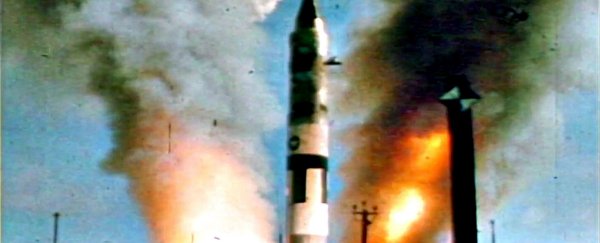
During the Cold War, the US and the Soviet Union built underground missile silos so they could launch nuclear weapons at each other at a moment's notice. But what exactly does that involve? In the latest episode of Veritasium, Derek gives us a preview of his upcoming TV documentary, Uranium: Twisting the Dragon's Tail, and takes us through the step-by-step process of launching a nuclear missile at one of the original Titan missile silos in the Arizona desert.
Inside is a deactivated Titan II rocket, which during the Cold War was armed with a 9-megaton thermonuclear bomb. If one of those had ever been detonated, it would have been around 650 times more powerful than the weapon that was dropped on Hiroshima, as Chuck Penson from the Titan Missile Museum explains to Derek.
But the first challenge when it comes to using one of these bombs actually has nothing to do with the weapons themselves, but the sound that they release when launched. In an open space this would be fine, but in an enclosed underground missile silo, the noise would be so powerful that it would rip apart the missiles before they took off. Because of this, all the silos are coated in acoustically absorbent tiles.
So once you know your silo can handle the sound waves of a nuclear launch, how exactly do you regulate the launch procedure to be speedy enough to perform in an emergency, but controlled enough so that a bomb doesn't launch by accident?
Luckily for Derek, the museum still happens to have an active launch system, which means he can take us through the exact procedure that would have set in motion World War 3. First of all, a launch order needs to come exclusively from the President of the United States, and is sent via a coded message of numbers and letters.
Next, two individuals are required to authenticate the order, before they begin the steps to make it happen - a process that's far simpler than you might imagine in today's security-conscious world. There are no multi-layered encryption codes happening here.
Watch the video above to see Derek go through the process from start to finish, and try not to panic too much when Penson tells him there's no "oops" button once the launch keys are turned. We can't help but wonder how many times during the Cold War a launch almost got to this point… and how close life as we know came to being wiped out.
The good news is that the Titan rockets went on to do some good for science once the Cold War wrapped up - the Voyager spacecraft was launched on top of one, and the Titan II rocket took Neil Armstrong to space for the first time.
We can't wait to see Derek's full documentary - if you're in the US, Uranium: Twisting the Dragon's Tail starts screening this week, on 28 July at 10pm Pacific Time and 9pm Central Time. The rest of us have a few more weeks to wait, find out when it's showing near you here.
